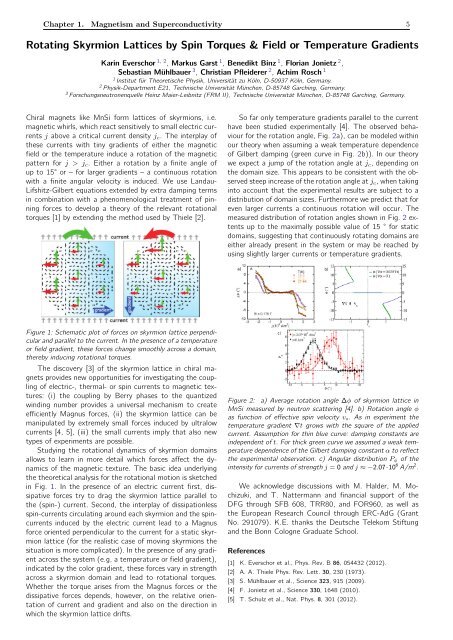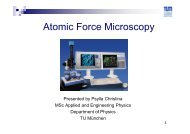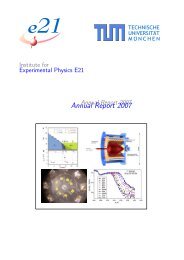Annual Report 2011 / 2012 - E21 - Technische Universität München
Annual Report 2011 / 2012 - E21 - Technische Universität München
Annual Report 2011 / 2012 - E21 - Technische Universität München
Create successful ePaper yourself
Turn your PDF publications into a flip-book with our unique Google optimized e-Paper software.
Chapter 1. Magnetism and Superconductivity 5<br />
Rotating Skyrmion Lattices by Spin Torques & Field or Temperature Gradients<br />
Karin Everschor 1, 2 , Markus Garst 1 , Benedikt Binz 1 , Florian Jonietz 2 ,<br />
Sebastian Mühlbauer 3 , Christian Pfleiderer 2 , Achim Rosch 1<br />
1 Institut für Theoretische Physik, Universität zu Köln, D-50937 Köln, Germany.<br />
2 Physik-Department <strong>E21</strong>, <strong>Technische</strong> Universität München, D-85748 Garching, Germany.<br />
3 Forschungsneutronenquelle Heinz Maier-Leibnitz (FRM II), <strong>Technische</strong> Universität München, D-85748 Garching, Germany.<br />
Chiral magnets like MnSi form lattices of skyrmions, i.e.<br />
magnetic whirls, which react sensitively to small electric currents<br />
j above a critical current density j c . The interplay of<br />
these currents with tiny gradients of either the magnetic<br />
field or the temperature induce a rotation of the magnetic<br />
pattern for j > j c . Either a rotation by a finite angle of<br />
up to 15° or – for larger gradients – a continuous rotation<br />
with a finite angular velocity is induced. We use Landau-<br />
Lifshitz-Gilbert equations extended by extra damping terms<br />
in combination with a phenomenological treatment of pinning<br />
forces to develop a theory of the relevant rotational<br />
torques [1] by extending the method used by Thiele [2].<br />
So far only temperature gradients parallel to the current<br />
have been studied experimentally [4]. The observed behaviour<br />
for the rotation angle, Fig. 2a), can be modeled within<br />
our theory when assuming a weak temperature dependence<br />
of Gilbert damping (green curve in Fig. 2b)). In our theory<br />
we expect a jump of the rotation angle at j c , depending on<br />
the domain size. This appears to be consistent with the observed<br />
steep increase of the rotation angle atj c , when taking<br />
into account that the experimental results are subject to a<br />
distribution of domain sizes. Furthermore we predict that for<br />
even larger currents a continuous rotation will occur. The<br />
measured distribution of rotation angles shown in Fig. 2 extents<br />
up to the maximally possible value of 15 ° for static<br />
domains, suggesting that continuously rotating domains are<br />
either already present in the system or may be reached by<br />
using slightly larger currents or temperature gradients.<br />
Figure 1: Schematic plot of forces on skyrmion lattice perpendicular<br />
and parallel to the current. In the presence of a temperature<br />
or field gradient, these forces change smoothly across a domain,<br />
thereby inducing rotational torques.<br />
The discovery [3] of the skyrmion lattice in chiral magnets<br />
provides new opportunities for investigating the coupling<br />
of electric-, thermal- or spin currents to magnetic textures:<br />
(i) the coupling by Berry phases to the quantized<br />
winding number provides a universal mechanism to create<br />
efficiently Magnus forces, (ii) the skyrmion lattice can be<br />
manipulated by extremely small forces induced by ultralow<br />
currents [4, 5], (iii) the small currents imply that also new<br />
types of experiments are possible.<br />
Studying the rotational dynamics of skyrmion domains<br />
allows to learn in more detail which forces affect the dynamics<br />
of the magnetic texture. The basic idea underlying<br />
the theoretical analysis for the rotational motion is sketched<br />
in Fig. 1. In the presence of an electric current first, dissipative<br />
forces try to drag the skyrmion lattice parallel to<br />
the (spin-) current. Second, the interplay of dissipationless<br />
spin-currents circulating around each skyrmion and the spincurrents<br />
induced by the electric current lead to a Magnus<br />
force oriented perpendicular to the current for a static skyrmion<br />
lattice (for the realistic case of moving skyrmions the<br />
situation is more complicated). In the presence of any gradient<br />
across the system (e.g. a temperature or field gradient),<br />
indicated by the color gradient, these forces vary in strength<br />
across a skyrmion domain and lead to rotational torques.<br />
Whether the torque arises from the Magnus forces or the<br />
dissipative forces depends, however, on the relative orientation<br />
of current and gradient and also on the direction in<br />
which the skyrmion lattice drifts.<br />
Figure 2: a) Average rotation angle ∆φ of skyrmion lattice in<br />
MnSi measured by neutron scattering [4]. b) Rotation angle φ<br />
as function of effective spin velocity v s. As in experiment the<br />
temperature gradient ∇t grows with the square of the applied<br />
current. Assumption for thin blue curve: damping constants are<br />
independent of t. For thick green curve we assumed a weak temperature<br />
dependence of the Gilbert damping constant α to reflect<br />
the experimental observation. c) Angular distribution P φ of the<br />
intensity for currents of strength j = 0 and j ≈ −2.07·10 6 A/m 2 .<br />
We acknowledge discussions with M. Halder, M. Mochizuki,<br />
and T. Nattermann and financial support of the<br />
DFG through SFB 608, TRR80, and FOR960, as well as<br />
the European Research Council through ERC-AdG (Grant<br />
No. 291079). K.E. thanks the Deutsche Telekom Stiftung<br />
and the Bonn Cologne Graduate School.<br />
References<br />
[1] K. Everschor et al., Phys. Rev. B 86, 054432 (<strong>2012</strong>).<br />
[2] A. A. Thiele Phys. Rev. Lett. 30, 230 (1973).<br />
[3] S. Mühlbauer et al., Science 323, 915 (2009).<br />
[4] F. Jonietz et al., Science 330, 1648 (2010).<br />
[5] T. Schulz et al., Nat. Phys. 8, 301 (<strong>2012</strong>).




